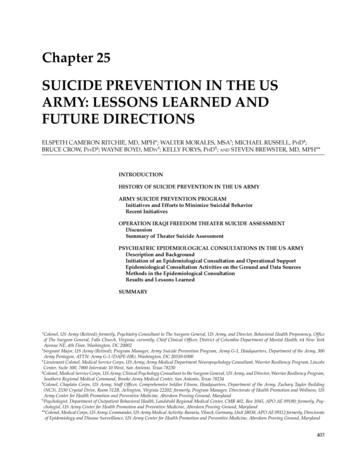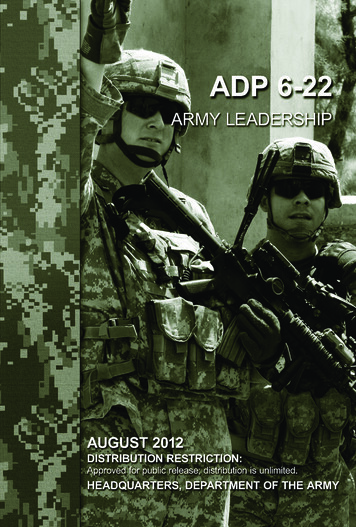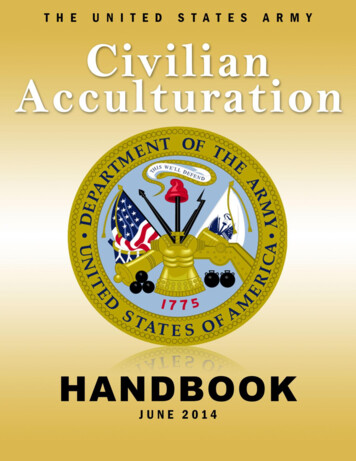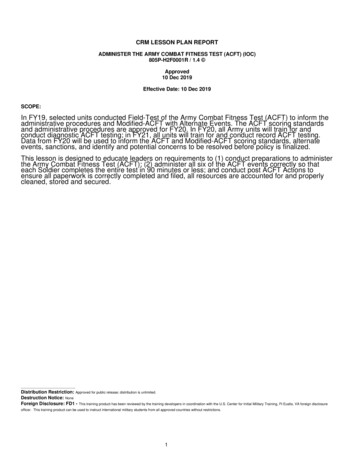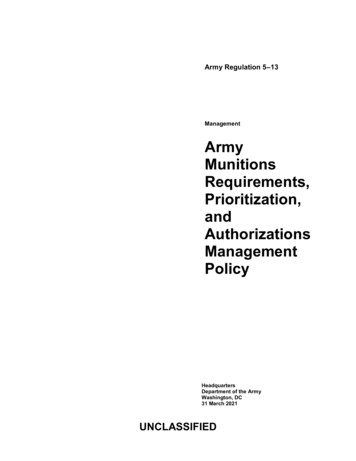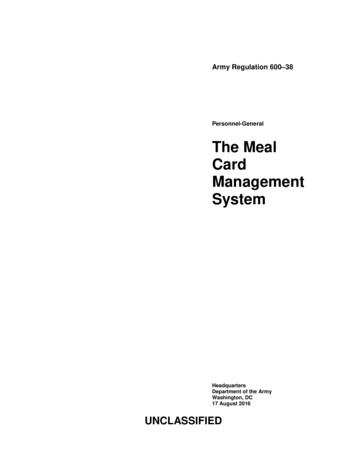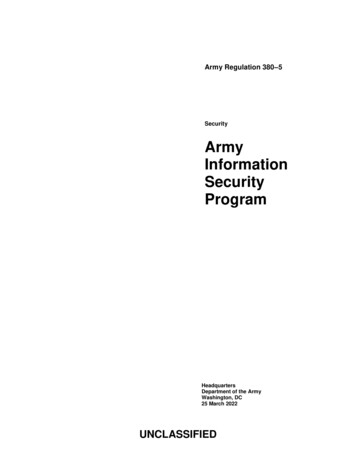
Transcription
Army Regulation uartersDepartment of the ArmyWashington, DC25 March 2022UNCLASSIFIED
SUMMARY of CHANGEAR 380– 5Army Information Security ProgramThis expedited revision, dated 25 March 2022—oCorrects the role of the Administrative Assistant to the Secretary of the Army as the Army program managementofficial for the Offices of Headquarters, Department of the Army Principal Officials in the National CapitalRegion (para 1 – 6).oAdds corresponding reference for Secretary of the Army classification authority (paras 2–2a and 2–2d).oAdds a new paragraph on process for classification challenges (para 2 –16).oUpdates the website address for the information security policy team (para 2–19c(4)).oOmits obsolete references to “For Official Use Only” or “FOUO” terminology as prescribed by DoDI 5200.48(chap 4 and throughout).oRemoves references to DD Form 2056 (Telephone Monitoring Notification Decal), which was cancelled 10December 2019 (para 5 – 12).oAdds definition of “legacy material” (glossary).oReplaces references to DoDM 5200.01, Volume 4, with DoDI 5200.48 addressing Controlled UnclassifiedInformation (throughout).
*Army Regulation 380 –5HeadquartersDepartment of the ArmyWashington, DC25 March 2022Effective 25 April 2022SecurityArmy Information Security ProgramProponent and exception authority.The proponent of this regulation is theDeputy Chief of Staff, G– 2. The proponent has the authority to approve exceptions to this regulation that are consistentwith controlling law and regulation. Theproponent may delegate this approval authority in writing to a division chief withinthe proponent agency in the grade ofColonel or the civilian equivalent. Activities may request a waiver to this regulation by providing justification that includes a full analysis of the expected benHistory. This publication is an expe- efits and must include formal review bydited revision.the activity’s senior legal officer. Allwaiver requests will be endorsed by theSummary. This regulation implementscommander or senior leader of the rethe policy set forth in Executive Order13526; DoDM 5200.01, Volumes 1 questing activity and forwarded throughtheir higher headquarters to the policythrough 3; and DoDI 5200.48.proponent. Refer to AR 25 –30 for specificApplicability. This regulation applies requirements.to the Regular Army, the Army NationalGuard/Army National Guard of the Army internal control process.This regulation contains internal controlUnited States, the U.S. Army Reserve,provisions in accordance with AR 11 –2and Department of the Army Civilian perand identifies key internal controls thatsonnel, unless otherwise stated.must be evaluated (see app B).Supplementation. Supplementationof this regulation and establishment ofcommand and local forms are prohibitedwithout prior approval by the DeputyChief of Staff, G– 2 (DAMI – sage@mail.mil.Suggested improvements. Users ofthis regulation are invited to send comments and suggestions for improvementson DA Form 2028 (RecommendedChanges to Publications and BlankForms) directly to the Deputy Chief ofStaff, G– 2 (DAMI– CDS), army.mil.Distribution. This regulation is available in electronic media only and is intended for the Regular Army, the ArmyNational Guard/Army National Guard ofthe United States, and the U.S. Army Reserve.Contents (Listed by paragraph and page number)Chapter 1General Provisions and Program Management, page 1Section IIntroduction, page 1Purpose 1 – 1, page 1References and forms 1 – 2, page 1Explanation of abbreviations and terms 1 – 3, page 1Responsibilities 1 – 4, page 1Records management (recordkeeping) requirements 1 – 5, page 1Section IIResponsibilities, page 1Administrative Assistant to the Secretary of the Army 1 – 6, page 1Deputy Chief of Staff, G – 1 1 – 7, page 1Deputy Chief of Staff, G – 2 1 – 8, page 1Commanders of Army commands, Army service component commands, and direct reporting units 1 – 9, page 2Commanders at all levels 1 – 10, page 2The security manager 1 – 11, page 3*This regulation supersedes AR 380–5, dated 22 October 2019.AR 380–5 25 March 2022UNCLASSIFIEDi
Contents—ContinuedSupervisors 1 – 12, page 4All Army personnel 1 – 13, page 4Section IIIProgram Management, page 4Applicability 1 – 14, page 4General principles 1 – 15, page 4Section IVSpecial Types of Information, page 5Restricted Data and/or Formerly Restricted Data 1 – 16, page 5Sensitive compartmented information, communications security information, and special access program information 1 – 17, page 5Section VExceptional Situations, page 6Military operations, exercises, and unit deactivations 1 – 18, page 6Waivers and exceptions to policy 1 – 19, page 6Section VICorrective Actions and Sanctions, page 6General 1 – 20, page 6Sanctions 1 – 21, page 7Reporting of security incidents 1 – 22, page 7Section VIIReports, page 7Reporting requirements 1 – 23, page 7Command security inspections 1 – 24, page 7Chapter 2Classification, page 7Section IClassification Principles, page 7Original versus derivative classification 2 – 1, page 7Delegation of authority 2 – 2, page 8Required training 2 – 3, page 8Section IIDerivative Classification, page 8Policy 2 – 4, page 8Accuracy responsibilities 2 – 5, page 8Required training 2 – 6, page 9Section IIIThe Original Classification Process, page 9General 2 – 7, page 9Classification criteria 2 – 8, page 9Levels of classification 2 – 9, page 10Duration of classification 2 – 10, page 10Reclassification of information declassified and released to the public under proper authority 2 – 11, page 10Communicating the classification decision 2 – 12, page 10Compilation 2 – 13, page 10Acquisition process 2 – 14, page 10Limitations and prohibitions 2 – 15, page 11Classification challenges 2 – 16, page 11AR 380–5 25 March 20221ii
Contents—ContinuedSection IVSecurity Classification Guides, page 11Policy 2 – 17, page 11Content 2 – 18, page 11Approval, distribution, and indexing 2 – 19, page 11Review, revision, and cancellation 2 – 20, page 12Section VNongovernment Research and Development Information, page 13Policy 2 – 21, page 13Chapter 3Declassification, Downgrading, Upgrading, and Destruction, page 13Section IArmy Declassification Program, page 13General 3 – 1, page 13Special program manager 3 – 2, page 13Declassification of Restricted Data and Formerly Restricted Data 3 – 3, page 15Declassification of other than Army information 3 – 4, page 15Section IIThe Automatic Declassification System, page 15General 3 – 5, page 15Exemption from automatic declassification 3 – 6, page 15Marking records exempted from automatic declassification 3 – 7, page 16Records review guidelines 3 – 8, page 17Army commands, Army service component commands, direct reporting units requirements 3 – 9, page 17Section IIIMandatory Declassification and Systematic Declassification Reviews, page 18Mandatory declassification reviews 3 – 10, page 18Mandatory declassification review appeals 3 – 11, page 18Systematic declassification reviews 3 – 12, page 18Section IVChange in the Level of Classification, page 19General 3 – 13, page 19Downgrading 3 – 14, page 19Upgrading 3 – 15, page 19Section VClassified Material Destruction Standards, page 19General 3 – 16, page 19Approved routine methods of destruction 3 – 17, page 19Technical advice on approved destruction devices and methods 3 – 18, page 20Chapter 4Controlled Unclassified Information, page 20General 4 – 1, page 20Chapter 5Access, Control, Safeguarding, and Visits, page 20Section IAccess, page 20Responsibilities 5 – 1, page 20AR 380–5 25 March 2022iii
Contents—ContinuedNondisclosure agreement 5 – 2, page 20Signing and filing the nondisclosure agreement 5 – 3, page 21Refusal to execute the nondisclosure agreement 5 – 4, page 21Debriefing and termination of classified access 5 – 5, page 21Access to Restricted Data, Formerly Restricted Data, and critical nuclear weapon design information 5 – 6, page 22Access by persons outside the Executive Branch 5 – 7, page 22Section IIControl Measures and Visits, page 23Responsibilities 5 – 8, page 23Care during working hours 5 – 9, page 23End-of-day security checks 5 – 10, page 24Emergency planning 5 – 11, page 24Classified discussions 5 – 12, page 25Removal of classified storage and information technology equipment 5 – 13, page 25Visits 5 – 14, page 25Classified meetings and conferences 5 – 15, page 25Section IIIAccountability and Administrative Procedures, page 27Equipment used in information technology networks 5 – 16, page 27Receipt of classified material 5 – 17, page 27Top Secret information 5 – 18, page 27Foreign government information 5 – 19, page 28Working papers 5 – 20, page 29Reproduction of Classified Material 5 – 21, page 29Section IVDisposition and Destruction of Classified Material, page 30Policy 5 – 22, page 30Methods and standards for destruction 5 – 23, page 30Records of destruction 5 – 24, page 31Chapter 6Storage and Physical Security Standards, page 31Section IGeneral, page 31Policy 6 – 1, page 31Physical security policy 6 – 2, page 31Section IIStorage Standards, page 31Standards for storage equipment 6 – 3, page 31Storage of classified information 6 – 4, page 31Procurement of new storage equipment 6 – 5, page 33Removal of classified information for work at home 6 – 6, page 33Safeguarding of U.S. classified information located in foreign countries 6 – 7, page 33Equipment designations and combinations 6 – 8, page 34Neutralization and repair of Government Services Agency-approved security containers and vaultdoors 6 – 9, page 34Maintenance and operating inspections 6 – 10, page 35Turn-in or transfer of security equipment 6 – 11, page 35Section IIIPhysical Security Standards, page 35General 6 – 12, page 35AR 380–5 25 March 20221iv
Contents—ContinuedVault and secure room (open storage area) construction standards 6 – 13, page 35Intrusion detection system standards 6 – 14, page 36Selection of equipment 6 – 15, page 37Intrusion detection system transmission and annunciation 6 – 16, page 37System requirements 6 – 17, page 38Installation, maintenance, and monitoring 6 – 18, page 38Access controls while material is not secured in security containers 6 – 19, page 38Chapter 7Transmission and Transportation, page 40Section IMethods of Transmission or Transportation, page 40Policy 7 – 1, page 40Dissemination outside the Department of Defense 7 – 2, page 40Top Secret information 7 – 3, page 41Secret information 7 – 4, page 41Confidential information 7 – 5, page 42Section IITransmission and Transportation of Classified Material, page 42Transmission and transportation of classified material to foreign governments 7 – 6, page 42Preparation of material for shipment by freight 7 – 7, page 43Envelopes or containers 7 – 8, page 43Addressing 7 – 9, page 43Mail channels with other government agencies 7 – 10, page 44Section IIIEscort or Hand-Carrying of Classified Material, page 44General provisions 7 – 11, page 44Documentation 7 – 12, page 44Hand-carrying or escorting classified material aboard commercial passenger aircraft 7 – 13, page 45Consignor/consignee responsibility for shipment of bulky material 7 – 14, page 46Chapter 8Security Education and Training, page 46Section IPolicy, page 46General policy 8 – 1, page 46Methodology 8 – 2, page 47Section IIBriefings and Training, page 47Initial security orientation 8 – 3, page 47Annual refresher training 8 – 4, page 47Training for managers and supervisors 8 – 5, page 48Section IIISpecial Requirements, page 48General policy 8 – 6, page 48Original classifiers 8 – 7, page 48Derivative classifiers 8 – 8, page 48Security program management personnel 8 – 9, page 48North Atlantic Treaty Organization briefing for cleared personnel 8 – 10, page 49Others 8 – 11, page 49Termination briefings 8 – 12, page 49AR 380–5 25 March 2022v
Contents—ContinuedProgram management 8 – 13, page 50Chapter 9Security Incidents and Reporting Involving Classified Information, page 50Section IPolicy, page 50Terms and categories of security incidents 9 – 1, page 50Reporting and notifications 9 – 2, page 51Security inquiries and investigations 9 – 3, page 51Classified information appearing in the public media 9 – 4, page 52Reporting results of the inquiry 9 – 5, page 52Reevaluation and damage assessment 9 – 6, page 52Debriefings in cases of unauthorized access 9 – 7, page 52Management and oversight 9 – 8, page 53Unauthorized absences, suicides, or incapacitation 9 – 9, page 53Negligence 9 – 10, page 54AppendixesA. References, page 55B. Internal Control Evaluation, page 61Figure ListFigure 3 – 1: Sample letter of certification, page 14GlossaryAR 380–5 25 March 20221vi
Chapter 1General Provisions and Program ManagementSection IIntroduction1–1. PurposeThis regulation develops Department of the Army (DA) policy for the classification, downgrading, declassification,transmission, transportation, and safeguarding of information requiring protection in the interests of national security.It primarily pertains to classified national security information, or classified information, but also addresses ControlledUnclassified Information (CUI). For purposes of this regulation, classified national security information, or classifiedinformation, is defined as information and/or material that has been determined, pursuant to Executive Order (EO)13526, or any applicable predecessor order, to require protection against unauthorized disclosure and is marked toindicate its appropriate classification. This regulation implements EO 13526; EO 13556; DoDM 5200.01, Volumes 1through 3; and DoDI 5200.48. This regulation also establishes policy on the safeguards of Restricted Data (RD) andFormerly Restricted Data (FRD), as specified by the Atomic Energy Act of 1954, as amended.1–2. References and formsSee appendix A.1–3. Explanation of abbreviations and termsSee glossary.1–4. ResponsibilitiesResponsibilities are listed in section II of this chapter.1–5. Records management (recordkeeping) requirementsThe records management requirement for all record numbers, associated forms, and reports required by this publication are addressed in the Records Retention Schedule–Army (RRS– A). Detailed information for all related recordnumbers, forms, and reports are located in Army Records Information Management System (ARIMS)/RRS – A athttps://www.arims.army.mil. If any record numbers, forms, and reports are not current, addressed, and/or publishedcorrectly in ARIMS/RRS – A, see DA Pam 25 – 403 for guidance.Section IIResponsibilities1–6. Administrative Assistant to the Secretary of the ArmyThe AASA is designated the Army program management official responsible for ensuring implementation of theinformation security program for Headquarters, Department of the Army (HQDA)/Operating Agency–22 (OA–22)organizations in the National Capital Region.1–7. Deputy Chief of Staff, G –1The DCS, G– 1 is responsible for executing the provisions of EO 13526, Section 5.4(d)(7), and will ensure that thesystems used to evaluate or rate civilian and military personnel performance include management of classified information as a critical element or item to be evaluated in the rating of:a. Original classification authorities.b. Security managers (SMs) or security specialists.c. All other personnel whose duties significantly involve the creation or handling of classified information, including personnel who regularly apply derivative classification markings.1–8. Deputy Chief of Staff, G –2The DCS, G– 2, will act as the designated DA senior agency official by the Secretary of the Army (SECARMY), todirect, administer, and oversee the Army’s information security program. The DCS, G – 2, will—a. Develop, coordinate, and oversee the Army Information Security Program.AR 380–5 25 March 20221
b. Provide program management through issuance of policy and operating guidance.c. Ensure DA commands adequately resource the program and meet established policies and procedures.d. Ensure all DA commands integrate security education, training, and awareness into their information securityprograms pursuant to EO 13526, DoDM 5200.01, Volume 3 and DoDI 5200.48.e. Provide staff assistance to DA commands in resolving day-to-day security policy and operating problems.f. Formulate policy governing the submission of security incident reports.g. As a Top Secret original classification authority (OCA), delegate Secret and Confidential OCA to other Armyofficials where appropriate.h. The Director, Counterintelligence, Human Intelligence, Security and Disclosure (DAMI – CD), on behalf of theDCS, G– 2, manages and provides oversight of all aspects of the Army Information Security Program. The Director(DAMI – CD) will—(1) Maintain a centralized system of control and coordination of security incident reporting and any resulting information security investigations worldwide.(2) Ensure that policy, procedures, and programs are developed for the implementation of EO 13526, EO 13556,DoDM 5200.01, Volumes 1 through 3, DoDI 5200.48, and other DoD issuances that implement EO 13526 and EO13556.(3) Monitor, evaluate, and report on the administration of the Army’s information security program. Ensure thatArmy commands (ACOMs), Army service component commands (ASCCs), and direct reporting units (DRUs) establish and maintain an ongoing self-inspection program, which includes periodic reviews and assessments of their classified and CUI.(4) Respond to information security matters pertaining to classified information that originated in an ACOM thatno longer exists and for which there is no successor in function.(5) Commit the resources required for the effective development of policy and oversight of the programs established by this regulation.(6) Serve as the approving authority of an information security curriculum for an Army Security Education, Training, and Awareness Program.1–9. Commanders of Army commands, Army service component commands, and direct reportingunitsCommanders of ACOMs, ASCCs, and DRUs will—a. Establish an information security program and ensure that all DA personnel execute procedures and processesin accordance with this regulation and related DoD issuances.b. Ensure an SM is appointed in writing for the command and subordinate commands, activities, and agencies thatcreate, handle, or store classified information and CUI to oversee the command’s information security program. TheSM should be of sufficient rank or grade to effectively discharge assigned duties and responsibilities. As a generalrequirement, the SM will be a commissioned officer (O - 3 or above), warrant officer, or civilian in the grade of GS 11/12 or above (or pay band equivalent).c. Ensure all SMs are afforded security training consistent with assigned duties and this regulation.d. Review and inspect the effectiveness of the information security program within the command annually or morefrequently based on program needs and the degree of involvement with managing classified information.e. Provide oversight of the responsibilities listed in paragraph 1 – 8 for subordinate commands.f. Ensure that all incidents specified in this regulation are reported accordingly.g. Include the management of classified information as a critical element or item in personnel performance evaluations, where appropriate as directed in the provisions of EO 13526.1–10. Commanders at all levelsCommanders at all levels and heads of agencies and activities are responsible for effective management of the information security program within commands, agencies, activities, or areas of responsibility (referred to within this regulation as commands). Commanders may delegate certain authorities to execute the requirements of this regulation,where applicable, but not their program management responsibilities. Security, including the safeguarding of classified and CUI and the appropriate classification and declassification of information created by DA personnel, is theresponsibility of the commander. The commander will—a. Establish written local information security policies and procedures and an effective information security education program, consistent with this regulation.b. Formulate and supervise measures or instructions necessary to ensure continuous protection of classified information, CUI, and related materials.AR 380–5 25 March 20222
c. Ensure that persons requiring access to classified information have met the appropriate security clearance eligibility, access standards, and have a need-to-know.d. Continually assess the individual trustworthiness of personnel who possess security clearance eligibility andwho have been given access to classified information.e. Designate an SM in writing. Ensure the SM is of sufficient rank or grade to effectively discharge assigned dutiesand responsibilities.f. Ensure the SM has been the subject of a favorably adjudicated, current background investigation appropriate forthe highest level of classification of information and the appropriate access to the level of information managed.g. Ensure the SM receives security training consistent with assigned duties and this regulation.h. Ensure adequate funding and personnel are available to allow security management personnel to manage andadminister applicable information security program requirements.i. Review and inspect the effectiveness of the information security program within the command annually or morefrequently based on program needs and classification activity.j. Ensure prompt and appropriate responses are given, or forwarded for higher echelon decision, to any problems,suggestions, requests, appeals, challenges, or complaints arising out of the implementation of this regulation.k. Ensure the prompt and complete reporting of security incidents, violations, and compromises related to classifiedinformation or the unauthorized disclosure of CUI, as directed herein and DoDI 5200.48.l. Ensure violations of this regulation, including suspected compromises or other threats to the safeguarding ofclassified information and the unauthorized disclosure of CUI, are reported and investigated in accordance with thisregulation.m. Ensure prompt reporting of credible derogatory information on assigned or attached personnel and contractors,to include recommendations for or against continued access to classified information in accordance with AR 380 – 49and AR 380 – 67.n. Ensure compliance with the requirements of this regulation when access to classified information is provided toindustry at a facility or location for which the command is responsible, in connection with a classified contract. If theclassified information is provided to industry at the contractor’s facility, ensure compliance with the provisions of AR380 – 49.o. Include the management of classified information as a critical element or item in personnel performance evaluations where appropriate, as directed in the provisions of EO 13526.1–11. The security managerThe SM is the principal advisor on information security in the command, and is responsible to the commander formanagement of the program. The SM will have direct access to the commander on matters affecting the informationsecurity program. The SM will—a. Advise and represent the commander on matters related to the classification, downgrading, declassification, andsafeguarding of national security information.b. Establish and implement an effective security education program for the command as required by chapter 8 ofthis regulation.c. Establish procedures for ensuring that DA personnel who handle classified material are properly cleared in accordance with AR 380 – 67.d. Advise and assist officials on classification problems and the development of classification guidance.e. Ensure that classification guides for classified plans, programs, projects, or mission are properly prepared, approved, distributed, and maintained.f. Conduct a periodic review of classifications assigned within the activity, to ensure classification decisions areconsistent with DoD classification guidelines.g. Consistent with operational and statutory requirements, review classified and CUI documents in coordinationwith the command records management officer. Continually reduce, by declassification, destruction, decontrol, orretirement, as appropriate, unneeded classified information and CUI.h. Oversee or conduct security inspections and spot checks for compliance with this regulation and other securityregulations and directives, and notify the commander of the results.i. Assist and advise the commander in matters pertaining to the enforcement of regulations governing the accessto, and the dissemination, reproduction, transmission, transportation, safeguarding, and destruction of classified information or CUI and material.j. Make recommendations, based on applicable regulations and directives, on requests for visits by foreign nationals and foreign government representatives. Provide security and disclosure guidance if the visit request is approved.For further guidance regarding official visits by foreign government representatives, refer to AR 380 – 10.AR 380–5 25 March 20223
k. Ensure violations of this regulation, including suspected compromises or other threats to the safeguarding ofclassified information and the unauthorized disclosure of CUI, are reported and investigated in accordance with thisregulation. Recommend appropriate corrective actions to address security violations.l. Ensure proposed public releases concerning classified or sensitive programs are reviewed to preclude the releaseof classified information, CUI, or other sensitive unclassified information exempt from release under the Freedom ofInformation Act (FOIA).m. Establish and maintain visitor control procedures in cases in which visitors are authorized access to classifiedinformation or to areas where classified material is stored and or processed.n. Issue contingency plans for the emergency destruction of classified information, when necessary, and for thesafeguarding of classified information used in or near hostile or potentially hostile areas.o. Be the single point of contact to coordinate and resolve classification or declassification problems.p. Report data as required by this regulation.1–12. SupervisorsSupervisory personnel have a key role in the effective implementation of the command’s information security program. Supervisors, by example, words, and deeds, set the tone for compliance by subordinate personnel with therequirements to properly safeguard, classify, and declassify information related to national security. Supervisorswill—a. Ensure subordinate personnel who require access to classified information are properly cleared in accordancewith AR 380 – 67.b. Ensure subordinate personnel are trained in, and comply with the requirements of this regulation, as well as localpolicy and procedures concerning the information security program.c. Continually assess the eligibility of subordinate personnel for access to classified information, and report to theSM any information that may have a bearing on that eligibility in accordance with AR 380 – 67.d. Include the management of classified information as a critical element or item in personnel performance evaluations, where appropriate.1–13. All Army personnelAll DA personnel, regardless of rank, title, or position, have a personal, individual, and official responsibility to safeguard information related to national security they have access to. All DA personnel will report, to the proper authority,actions by others or any other matters that could lead to, or that have resulted in, the unauthorized disclosure or compromise of classified information or CUI.Section IIIProgram Management1–14. ApplicabilityThis regulation governs the DA information security program and applies to all DA personnel as defined in the termssection of the glossary. Contractors will comply with the terms of this regulation and any information security programrequirements as required by the terms of their contracts.1–15. General principlesa. DA personnel and DA contractors will mark all classified information and material, regardless of media (forexample, paper documents, emails, slide presentations, and web pages) in accordance with DoDM 5200.01, Volume2. CUI will be marked in accordance with DoDI 5200.48.(1) In the event of any marking conflict with this regulation, DoDM 5200.01, Volume 2, DoDI 5200.48 or otherArmy regulations, personnel will follow the DoDM 5200.01, Volume 2 and DoDI 5200.48.(2) Where DoDM 5200.01, Volume 1 refers to waivers and/or exceptions, all requests will be through DCS, G – 2(DAMI – CD) and in accordance with paragraph 1 – 19.b. This regulation does not establish policy for the safeguarding of special category information which is coveredelsewhere, to include AR 380 –28, AR 380 –40, special access programs (SAPs), and alternative compensatory controlmeasures (see AR 380 – 381).c. Information may be originally classified only if all of the following conditions are met:(1) An OCA is classifying the information.(2) The information is owned by, produced by or for, or is under the control of the U.S. Government.AR 380–5 25 March 20224
(3) The information falls within one or more of the classification categories listed in EO 13526, Section 1.4.(4) The OCA determines the unauthorized disclosure of the information reasonably could be expected to result indamage to the national security, which includes defense against transnational terrorism, and the OCA is able to identifyor describe the anticipated damage.d. I
sage@army.mil. Distribution. This regulation is availa-ble in electronic media only and is in-tended for the Regular Army, the Army National Guard/Army National Guard of the United States, and the U.S. Army Re-serve. Contents (Listed by paragraph and page number) Chapter 1 General Provisions and Program Management, page 1 Section I


